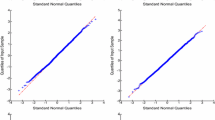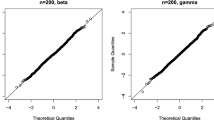Abstract
This paper discusses efficient estimation for the additive hazards regression model when only bivariate current status data are available. Current status data occur in many fields including demographical studies and tumorigenicity experiments (Keiding, 1991; Sun, 2006) and several approaches have been proposed for the additive hazards model with univariate current status data (Lin et al., 1998; Martinussen and Scheike, 2002). For bivariate data, in addition to facing the same problems as those with univariate data, one needs to deal with the association or correlation between two related failure time variables of interest. For this, we employ the copula model and an efficient estimation procedure is developed for inference. Simulation studies are performed to evaluate the proposed estimates and suggest that the approach works well in practical situations. An illustrative example is provided.
Similar content being viewed by others
References
Andersen P K, Gill R D. Cox’s regression model for counting processes: A large sample study. Ann Statist, 1982, 10: 1100–1120
Bickel P, Klaassen C, Ritov Y, et al. Efficient and Adaptive Estimation for Semiparametric Models. Baltimore: Johns Hopkins University Press, 1993
Clayton D G. A model for association in bivariate life tables and its application in epidemiological studies of familial tendency in chronic disease incidence. Biometrika, 1978, 65: 141–151
Ding A A, Wang W. Testing independence for bivariate current status data. J Amer Statist Assoc, 2004, 99: 145–155
Dunson D B, Dinse G E. Bayesian models for multivariate current status data with informative censoring. Biometrics, 2002, 58: 79–88
Genest C, Rivest L P. Statistical inference procedures for bivariate Archimedean copulas. J Amer Statist Assoc, 1993, 88: 1034–1043
Goggins W B, Finkelstein D M. A proportional hazards model for multivariate interval-censored failure time data. Biometrics, 2000, 56: 940–943
Guo S W, Lin D Y. Regression analysis of multivariate grouped survival data. Biometrics, 1994, 50: 632–639
Hougaard P. Analysis of Multivariate Survival Data. New York: Springer, 2000
Huang J. Efficient estimation for the proportional hazards model with interval censoring. Ann Statist, 1996, 24: 540–568
Huang J, Rossini A J. Sieve estimation for the proportional-odds failure-time regression model with interval censoring. J Amer Statist Assoc, 1997, 92: 960–967
Jewell N P, van de Laan M, Lei X. Bivariate current status data with univariate monitoring times. Biometrika, 2005, 92: 847–862
Keiding N. Age-specific incidence and prevalence: A statistical perspective. J Roy Statist Soc A, 1991, 154: 371–412
Lin D Y, Ying Z L. Semiparametric analysis of the additive risk model. Biometrika, 1994, 81: 61–71
Lin D Y, Oakes D, Ying Z. Additive hazards regression for current status data. Biometrika, 1998, 85: 289–298
Lin D Y, Ying Z L. Semiparametric and nonparametric regression analysis of longitudinal data. J Amer Statist Assoc, 2001, 96: 103–126
Martinussen T, Scheike T H. Efficient estimation in additive hazards regression with current status data. Biometrika, 2002, 89: 649–658
Oakes D. Bivariate survival models induced by frailties. J Amer Statist Assoc, 1989, 84: 487–493
Shen X, Wong W H. Convergent rates of sieve estimates. Ann Statist, 1994, 22: 580–615
Sun J. The Statistical Analysis of Interval-Censored Failure Time Data. New York: Springer, 2006
Tong X, Chen M H, Sun J. Regression analysis of multivariate interval-censored failure time data with application to tumorigenicity experiments. Biometrical J, 2008, 50: 364–374
Wang W, Ding A A. On assessing the association for bivariate current status data. Biometrika, 2000, 87: 879–893
Wang L, Sun J, Tong X. Efficient estimation for the proportional hazards model with bivariate current status data. Lifetime Data Anal, 2008, 14: 134–153
Zeng D L, Cai J W, Shen Y. Semiparametric additive model for interval-censored data. Statistica Sinica, 2006, 16: 287–302
Author information
Authors and Affiliations
Corresponding author
Rights and permissions
About this article
Cite this article
Tong, X., Hu, T. & Sun, J. Efficient estimation for additive hazards regression with bivariate current status data. Sci. China Math. 55, 763–774 (2012). https://doi.org/10.1007/s11425-012-4381-3
Received:
Accepted:
Published:
Issue Date:
DOI: https://doi.org/10.1007/s11425-012-4381-3
Keywords
- bivariate current status data
- copula model
- counting processes
- efficient estimation
- joint survival function




